We visited Vienna for the first time in 2009 and then later in 2016. Located on the banks of River Danube and the Capital of the Republic of Austria, it is one of Europe’s most visited cities.
The Hofburg – Located in the old town, the Hofburg area covers a collection of imperial and court buildings that was occupied by the ruling Habsburg dynasty between the 13th and early 20th centuries. Basically it was Vienna’s original city centre where the Imperial family lived, worked and ruled. Some parts now house visitor attractions, but others have administrative roles or serve as venues for conferences, trade fairs and even concerts. You can wander around the public courtyards, parks and squares for free, but almost all the public attractions inside buildings need their own entrance ticket.
Each ruler in the imperial Habsburg family wanted to put their own stamp on Hofburg resulting in a complex consisting of numerous buildings with architecture reflecting various periods – Gothic, Renaissance, Baroque, and Rococo. This vast complex covers 59 acres with 18 groups of buildings, including 19 courtyards and 2,600 rooms. The domed St. Michael’s wing was one of the most exuberant wings of the imperial palace. It was originally designed by Fischer von Erlach in the 18th century in Baroque style, but updated towards the end of the 19th century.
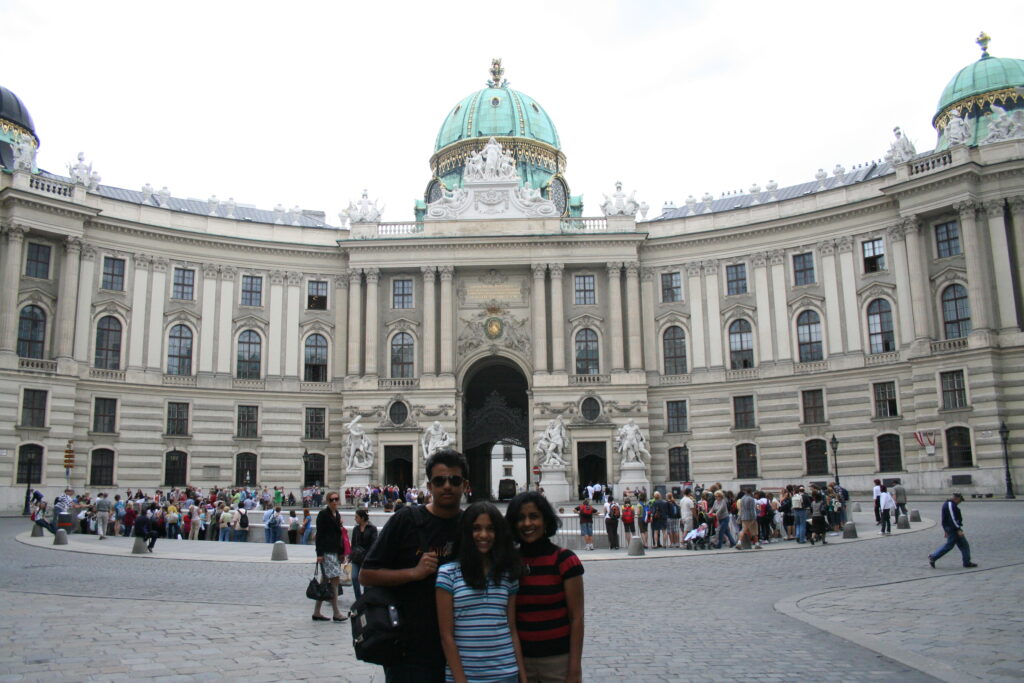
Once you enter through the St. Michael’s gate, the main courtyard within the complex itself has the huge 1846 monument to Emperor Franz. Franz’s double numerals come from holding two different Emperor titles: head of the Holy Roman Empire and head of the Austrian Empire. The Sisi Museum and the Imperial Apartments are in this area. The Sisi Museum examines the life and character of the iconic Empress Elisabeth (1837-1898). A ticketed self-guided-tour also includes access to the Imperial Apartments (Kaiserappartements), which take you through the rooms where Elisabeth and her husband Emperor Franz Joseph (1830-1916) lived.



You then pass through another gate, the Schweizertor. Built in 1552-1553, this Swiss Gate first allowed access to Hofburg palace 470 years ago. It now forms an arched gateway between two notable courtyards in the former Hofburg home of the Habsburgs. On one side you have the Schweizerhof, which contains the Schatzkammer (crown jewels) and the Hofburgkapelle (court chapel). On the other side you have the monument to Emperor Franz II/I).


Another building in Hofburg is the Neue Burg which is a large wing that extends out from one side of the Hofburg and provides a home for numerous visitor attractions, that include National Library, Ephesos Museum, Arms and Armour, Historical Musical Instruments collection etc. The huge Heldenplaz square in front of the Neue Burg has the Burgtor Gates and the large equestrian monuments to Prinz Eugen von Savoyen and Archduke Karl. The Burgtor gate on one side of the Heldenplaz square leads to Maria-Theresien-Platz.


Maria-Theresien-Platz – The plaza which is near the Imperial Palace, is dominated by the 2 magnificent buildings of Kunsthistorisches museum(Art History Museum) and the Naturhistorisches Museum(Museum of Natural History). In front of Kunsthistorisches museum is the grand monument of Empress Maria Theresa. The construction of the plaza took most of later part of 1800 and the unveiling of the monument took place in 1888. The Empress herself towers over statues and reliefs of military leaders and other personalities from the fields of art, science, administration, including Haydn, Gluck, and Mozart.



The Museum of Natural History (Naturhistorisches Museum) opened in 1889, is best known for its huge Dinosaur Hall and for the world’s largest exhibit of meteorites (which includes the Tissint meteorite from Mars that fell in Morocco in 2011). Its 39 exhibit halls trace such subjects as the origins and development of humans and the evolution of human culture from prehistoric times.
the Art History Museum(Kunsthistorisches museum) opened 2 years later in 1891. It houses art collections of the Hapsburg royal family. It has the world’s largest collection of works by Pieter Bruegel the Elder, including his masterpiece Tower of Babel. There are also paintings by Raphael, Bellini, Caravaggio, and Vermeer.
Belvedere Palace – This baroque palace complex was built as a summer residence of Prince Eugene of Savoy. This huge building complex consists of two Baroque palaces (the Upper and Lower Belvedere), the Orangery, and the Palace Stables.
Upper Belvedere was built between 1717-1723. Home to the majority of the Belvedere Palace’s vast art collection, this magnificent building is widely considered a piece of art in its own right. The Upper Belvedere was transformed into a picture gallery at the end of the eighteenth century.

Lower Belvedere was built between 1712-1717 and this is where Prince Eugene actually lived. After Prince Eugene died, his niece Victoria sold the place to Maria Theresa who later created an ancestors’ gallery of the Habsburg dynasty in the Lower Belvedere, as was the custom in all other palaces belonging to the imperial family. The grounds between the two palaces has beautifully manicured garden, decorative fountains and cascades, and baroque sculptures.


We spent a couple of hours visiting the art museum in the Belvedere Palace. It has an extensive collection of sculptures and panel paintings from the 12th to the 16th centuries. But it is perhaps best known for Austrian Symbolist artist Gustav Klimt’s The Kiss, a masterpiece of early modern art.




The Character Heads by Franz Xaver Messerschmidt – This remarkable collection of contorted faces were sculpted in 1700 and are on display in Belvedere Palace. Franz Xaver Messerschmidt was an 18th century sculptor who studied and worked in Vienna in the 1750-1770. Nobody quite knows exactly what Messerschmidt attempted to portray in these sculptures.
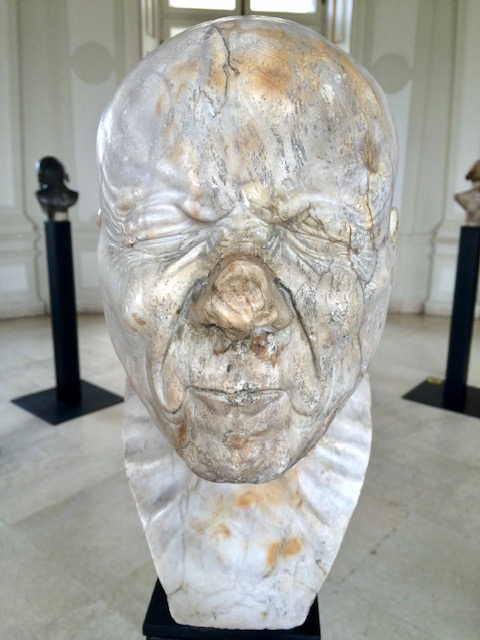
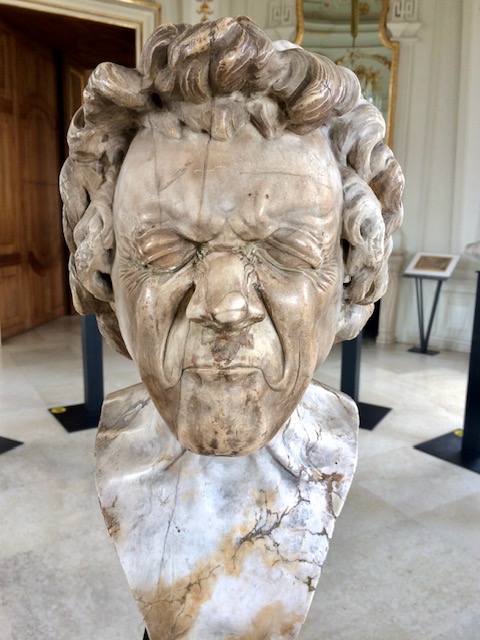

The Vienna State Opera House – This massive Opera house was built in 1869 and is one of the leading opera houses in the world. Each season, the schedule features 350 performances of more than 60 different operas and ballets. The interior has a grand and shiny staircase leading to the first floor. Capable of accommodating an audience of 2,211 along with 110 musicians, the Opera House is also home to the Vienna Philharmonic Orchestra. English language behind-the-scenes guided tours are available.


St. Stephen’s Cathedral – St. Stephen’s Cathedral, with its multi-colored tile roof, is one of the city’s most recognizable building and the seat of the Archbishop of Vienna since 1722. The current structure in Stephanplatz, stands on the ruins of two earlier churches, the first a parish church consecrated in 1147. It has 256 stairs from the top to the bottom. The church’s 137-meter(446 ft) high tower, affectionately referred to by the city’s inhabitants as “Steffl” was constructed between 1368 to 1433.



The cathedral boasts 18 altars, but the centerpiece of them all is the High Altar, which portrays the stoning of the cathedral’s namesake, Saint Stephen. The High Altar was built in the 1640s using marble from Styria and Tyrol in Austria, as well as from Poland.
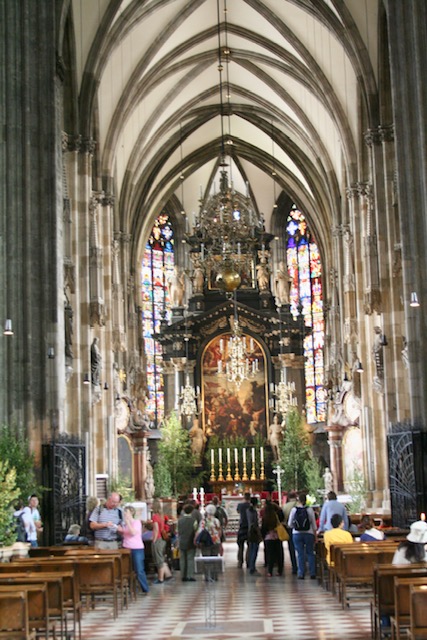
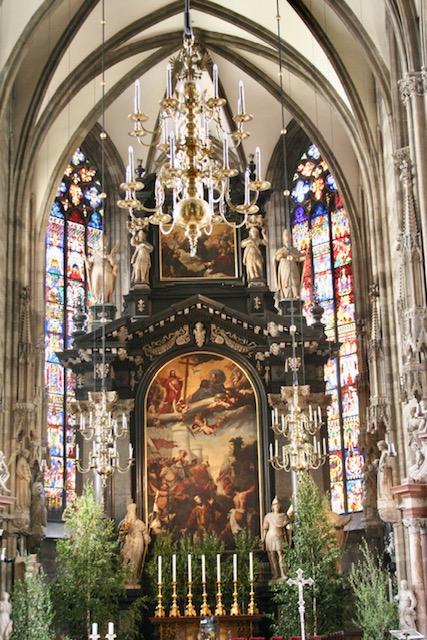
One can climb up (343 steps) to the top to check out spectacular views of the city. For those not wanting to tackle the stairs, a fast lift takes visitors to a viewing platform.

Vienna City Hall – This splendid building was erected between 1872 and 1883. The City Hall was built in gothical style, with a tower similar to gothic cathedrals. Today the City Hall is the head office of Vienna’s municipal administration. More than 2000 people work in the building. Remarkable for its size, it occupies nearly 14,000 square meters of the former Parade Ground. Tours of the building are available on certain weekdays.


St. Peter’s Catholic Church (Peterskirche) – built between 1702-1732, and modeled on St. Peter’s in Rome, this church is conveniently located just off the pedestrian area in central Vienna. Although not very big, it has an interior as impressive as its exterior. It is well worth spending 10 minutes checking out the interior of this church. The church is also noted for its frequent organ recitals.
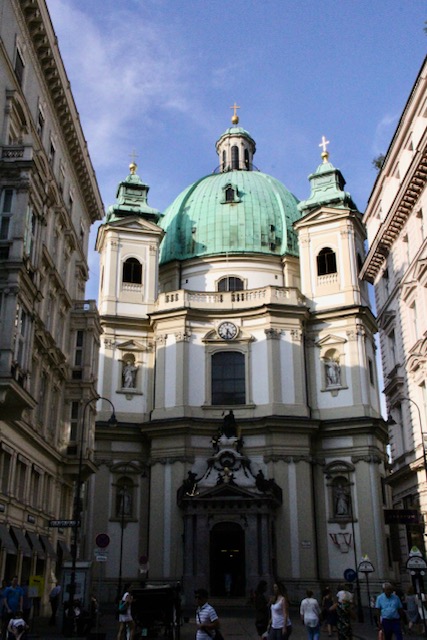
Jesuit Church – This twin tower church also known as University Church, was built between 1623 and 1627 on the site of an earlier chapel, at the time when the Jesuits merged their own college with the University of Vienna’s philosophy and theology faculty. The emperor broke ground for both college and church, with the church itself dedicated to Saints Ignatius Loyola and Francis Xavier. The church was remodeled between 1703 and 1705 after which the church was re-dedicated to the Assumption of Mary. It is well worth spending 15-20 minutes viewing the richly decorate interior of the church.
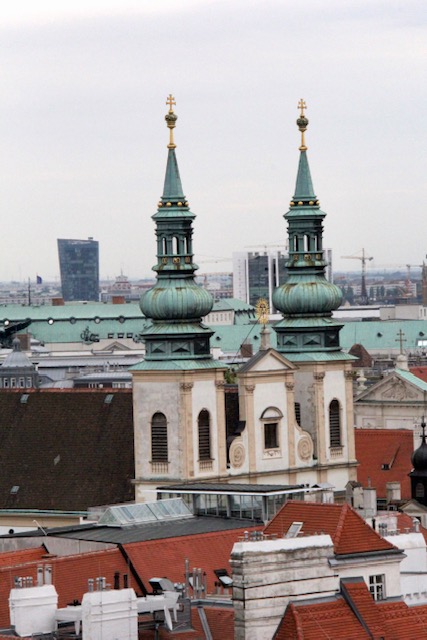
Vienna’s famous Demel Café – Founded in 1786, the famous Demel is the oldest café and bakery in Vienna. Officially known as Hofzuckerbäckerei Demel this exquisite café serves pastries and cakes carefully prepared by hand to traditional centuries-old recipes. On the day we visited the cafe, we were seated immediately and the service was great. The coffee and cake we ordered was quite good. We were also allowed to visit the kitchen area where we saw a cake being prepared.


Colorful homes of Hundertwasserhaus – Built between 1983-1986, this residential complex is the work of Austrian artist Friedensreich Hundertwasser. This brightly colored complex resembles a colorful puzzle with uneven shaped façade with branches and trees growing from windows and colorful columns holding the building.





Alongside the Hundertwasserhaus, you can also visit Hundertwasser Village, a shopping centre built in the same style, and the Hundertwasser Museum, where the artist’s other works are exhibited.



The Austrian Parliament Building – Built in 1883, it is the home of Austria’s National and Federal Parliament since 1918. It contains over one hundred rooms, prominent among them are the Chambers of the National Council, the Federal Council, and the former House of Deputies. The building also includes libraries, lobbies, dining rooms, bars and gym. Bronze statues of horse tamers are located in front of the Parliament building.

The front of the Austrian Parliament building also has the Pallas Athene Fountain with its four-meter-high statue adorned with a gilded helmet and lance, along with figures symbolizing the Rivers Danube, Inn, Elbe, and Moldau. English language guided tours are available from the Visitor Center.



Other sites around Vienna
- Schönbrunn Palace and Gardens – The spectacular 18th-century Schönbrunn Palace (Schloss Schönbrunn) is worth visiting not only for its magnificent architecture, but also for its beautiful park-like setting. One of Vienna’s top tourist attractions, this beautiful Baroque palace contains more than 1,441 rooms and apartments, including those once used by Empress Maria Theresa.
- The Franciscan Church: St. Jerome
- Burgtheater: Austria’s National Theater – Originally built between 1869-1888, the building was badly destroyed in WWII bombings but rebuilt in its original form by 1955. The building’s exterior and interior are quite impressive.
- Judenplatz Holocaust Memorial
- Sigmund Freud Museum
- The Danube Tower – The tower opened in 1964 and is the tallest building in Austria at 252m tall. For spectacular view over the Danube River, take the elevator ride to the observation deck at 150 meters. There is a cafe and a restaurant at the top.
- Karlskirche – or St. Charles Church is a gorgeous baroque church located on the south side of Karlsplatz. The church is dedicated to St. Charles Borromeo, and was built in 1737 and is Vienna’s most important baroque religious building.
- Kärntner Strasse and the Donner Fountain – Shopping in Vienna’s most elegant street, Kärntner Strasse which also has the attractive Donner Fountain, built in 1739.